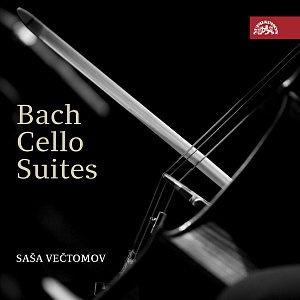
Saša Večtomov. Bach Cello Suites. Supraphon CD SU42752 Released 2020.
Previously only available on vinyl released 1986.
Recorded in the Organ Hall of the House of Artists (Rudolfinum) from 27 August to 4 September, 1984.
cello made by Alessandro Gagliano, 1712.
Introduction.
Večtomov is a prominent Czech cellist born in 1930 who sadly died early in 1989. A comprehensive biography is available here:
https://www.bach-cantatas.com/Bio/Vectomov-Sasa.htm
Within the above, I note with interest the statement that Večtomov mastered 30 distinct forms of Glissando (a continuous slide upwards or downwards between two notes)! Some are on display in these recordings particularly the Courantes! That I think gives you a very good clue as to what you might expect.
This is indeed a romantic interpretation typical I feel of the 1980s with large concert hall filling tone and plenty of vibrato.
The quality of the recording is I believe excellent. The proviso here, is that I auditioned via a streaming service. Never the less this was via a decent DAC and then my normal hi fi system. I have to say I baulk at paying a significant sum for a recording 36 years old! I would suggest this is a purchase for dedicated followers of the artist. Additional reasons will become apparent!
A prospective purchaser should be aware that this recording was originally released on two LPs, with total time barely above one and a half hours. This is achieved by omission of most repeats.
The Music.
I am starting with the third Suite as I always believe in sharing positivity first! This is played in a grand style and displays Večtomov’s tone well with technical expertise, musical phrasing, and notable contrasts especially in the Bourees. The Sarabande was beautifully shaped displaying the sweet quality the artist is commended for elsewhere (his record label). The Allemande was nice and bouncy and the Gigue positively feisty and brisk.
Another favourable impression was the second Prelude where the romantic and unhurried approach underlined the sombre mood of the movement.
The sixth Prelude was slow and lacked attack but this was compensated for by an ethereal almost ghostly feel.
Unfortunately for me the remaining Suites were less enjoyable. I am going to assume this is a subjective issue but would urge a listener with no previous experience of Večtomov’s style to check out this music on streaming services first before purchase.
Evidence of this:
Very slow fourth Suite Prelude sounding ponderous and postured.
Many movements sounding like a march as opposed to a dance, These include the fourth Bourees, and fifth Prelude also very slow at almost 8 minutes.
Amazingly, the first Suite Sarabande was treated to this regimental style.
Some of the dynamic contrasts within movements were very dramatic. For example within the first Gigue, otherwise surprisingly slow.
Essentially, to me this interpretation sounded rather theatrical, a similar impression I gained from Tortelier’s second recording of a similar era. However, Večtomov in places makes Tortelier sound almost like a wallflower type of character!
Conclusion.
In summary, this is a recording for enthusiasts of Večtomov. They are out there, witness high prices paid for vinyl copies. Otherwise it comes with a strong advisory to listen before purchase. The third Suite is very good and the interpretation as a whole has made me stop and consider how I judge recordings of the Suites. It may be that Večtomov is just so different as to be worthy of praise!
Charles.